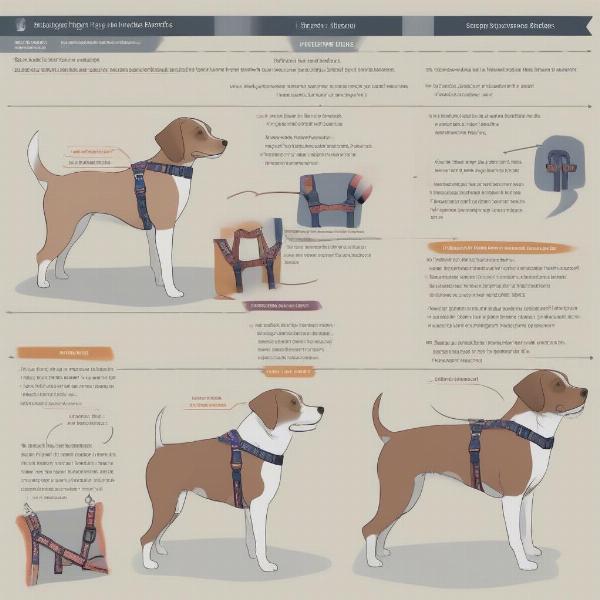A dog harness with a seat belt is a crucial piece of equipment for any pet owner who travels with their furry friend. It not only protects your dog in case of an accident but also prevents distractions while driving, ensuring a safer journey for everyone. Choosing the right harness and seat belt combination can be overwhelming with so many options available. This article will guide you through everything you need to know about dog harnesses with seat belts, from choosing the right one to ensuring proper usage.
Choosing the Right Dog Harness with Seat Belt
Selecting the right harness and seat belt is paramount for your dog’s safety and comfort. Consider the following factors:
- Size and Fit: The harness should fit snugly but not restrict your dog’s movement. Measure your dog’s chest girth and consult the manufacturer’s sizing chart.
- Material: Look for durable, non-toxic materials that are comfortable against your dog’s skin. Nylon or polyester webbing are common choices.
- Crash Test Certification: Opt for harnesses that have been crash-tested by a reputable organization like the Center for Pet Safety.
- Attachment Type: Most dog seat belt attachments clip onto the harness and then buckle into the car’s seat belt receptacle. Ensure compatibility with your car.
- Comfort Features: Padding, adjustable straps, and breathable materials can enhance your dog’s comfort during car rides.
Types of Dog Harnesses for Car Travel
There are several types of harnesses suitable for car travel:
- Step-in Harnesses: These are easy to put on and take off, making them a good choice for puppies or dogs who are not used to wearing harnesses.
- Overhead Harnesses: These harnesses slip over the dog’s head and fasten around the chest, providing a secure fit.
- Vest Harnesses: These harnesses offer more coverage and support than other types, making them a good choice for larger dogs or dogs who are prone to pulling.
 Different types of dog harnesses suitable for car travel, including step-in, overhead, and vest harnesses.
Different types of dog harnesses suitable for car travel, including step-in, overhead, and vest harnesses.
Using a Dog Harness with Seat Belt Correctly
Proper usage is key to maximizing safety and effectiveness:
- Secure Fit: Ensure the harness is snug but allows for comfortable breathing and movement. You should be able to fit two fingers between the harness and your dog.
- Proper Attachment: Make sure the seat belt attachment is securely clipped to the harness and buckled into the seat belt receptacle.
- Positioning: Place your dog in the back seat, preferably in the middle, to minimize injury in case of an accident.
- Regular Checks: Periodically check the harness and seat belt for wear and tear and replace them if necessary.
Why Should I Use a Dog Harness with a Seat Belt?
What are the benefits of using a dog harness with a seat belt? A dog harness and seat belt provides numerous benefits, including: increased safety for your dog and passengers during sudden stops or accidents, reduced driver distraction by preventing your dog from roaming freely in the car, and increased peace of mind knowing your furry companion is secure during travels.
Keeping Your Dog Comfortable During Car Rides
How can I make car rides more comfortable for my dog? Introduce car rides gradually and associate them with positive experiences, such as short trips to the park. Provide familiar toys or blankets to create a sense of security. Ensure proper ventilation and avoid feeding your dog immediately before a car ride to prevent car sickness. Take breaks during long journeys to allow your dog to stretch their legs and relieve themselves.
Conclusion
A dog harness with a seat belt is an essential investment for any dog owner who travels with their pet. By choosing the right harness, using it correctly, and taking steps to make your dog comfortable, you can ensure safe and enjoyable car rides for both you and your furry friend. Remember to prioritize safety and comfort when selecting and using a dog harness with a seat belt.
FAQs
- What type of harness is best for car travel? Crash-tested harnesses, specifically vest harnesses, offer the most protection in an accident.
- Is it legal to drive with a dog unrestrained in the car? Laws vary by location, but unrestrained pets can be a safety hazard and may be illegal in some areas.
- Can I use a regular dog leash as a seat belt? No, regular leashes are not designed for car safety and can break or cause injury in an accident.
- Where should my dog sit in the car? The back seat, preferably the middle, is the safest location for your dog.
- How do I get my dog used to wearing a harness in the car? Introduce the harness gradually and reward your dog for wearing it. Start with short car rides and gradually increase the duration.
- What should I do if my dog gets car sick? Consult your veterinarian. There are medications and remedies available to help with car sickness.
- How often should I replace my dog’s car harness? Replace the harness if it shows any signs of wear and tear or after any accident.
dog harness and seat belt
dog seat belt harness
dog harness seat belt
dog harness for seatbelt
About ILM Dog
ILM Dog is your one-stop resource for expert advice on dog care, offering guidance on everything from breed selection and training to health, nutrition, and travel tips. We are dedicated to providing dog owners worldwide with reliable, practical information to ensure their furry companions live happy, healthy lives. For personalized advice or further inquiries, contact us at [email protected] or call us at +44 20-3965-8624. Visit ILM Dog today for all your dog care needs.